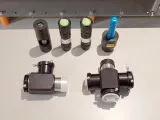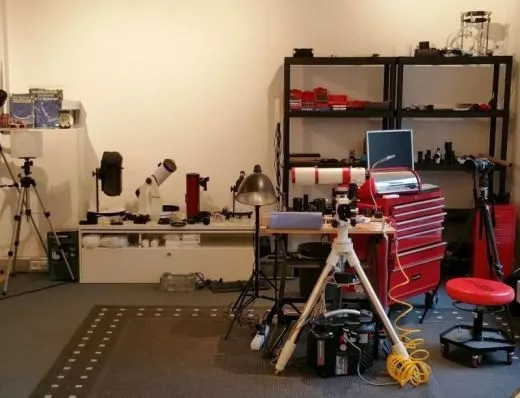- Details
- More images
Products description
We are always asked or asked whether we really check and adjust and / or adjust the telescopes, mounts and accessories.
Yes, we check and adjust every telescope, accessory or mount before shipping.
The telescope specialists are not discounters and cannot / do not want to serve the mass market.
We are a small team of experienced specialists who are committed to delivering flawless products. This service sets us apart from the other shops.
We may work up to several hours on a telescope to produce the optical and mechanical quality that we would personally expect if we bought from an astro dealer.
The telescopes tend to come from the manufacturers in an adjustment state that is sufficient for astronomy beginners because the beginner would often not recognize the difference because he lacks experience. But at least we make the contribution that everything works and is then adjusted so well that the beginner can be sure that everything is as the telescope allows and that he does not lose the joy of astronomy.
We are the only (!) Astronomy dealer who has been doing this for every product since 2008. In order to be able to do this professionally, we have acquired many expensive measuring devices and measuring tools over the years or have them developed specifically for our needs.
Everyone who visits our exhibition on the outskirts of Munich can convince themselves and we describe what we do in the optimization.
Optical workbench:
This is our optical workbench on which we adjust and optimize the telescopes such as Newton, Refraktor (Achromat or Apochromat), Schmidt-Cassegrain (SC), Ritchey Chrétien (RC), Maksutov and others.
Our alignment laser (collimator):
We use different alignment lasers for different requirements or tasks.
The first laser is only to be aligned for the positioning of the telescope on the artificial star. For adjustment, this is only suitable for private and visual purposes. These lasers are too imprecise. We'll preselect them, but they won't be really good either. The laser spot is also too thick / big. An exact adjustment of a Newton is not possible. The accuracy is sufficient for visual observation from f / 5.
The second alignment laser from Hotech is already good and has a crosshair. We use this to adjust a Newton when it has to go fast. So when a star friend buys a telescope in our exhibition and wants to take it with them. It is for 1.25 "and 2" focusers.
The third laser is from Farpoint and has a very fine laser point. This means that adjustments can be made very precisely and sensitively. That is for 1.25 "and 2" OAZ. The fine laser allows the position within the center marking and the reflection back to the laser to be recognized very precisely.
The fourth adjustment laser is from Howie Glatter and is equipped with a line grating. A very high-precision and high-quality laser with which we adjust the affordable Newtonian for beginners. The entry-level telescopes often do not have a center mark on the main mirror or the center mark is not exactly in the middle. This line pattern can be used to clearly determine and correct this. The laser is usually more expensive than the telescope to be adjusted. The cheap telescope is partially so misaligned that the reflected laser point can no longer be found in the viewing window of the laser. Through the line pattern you can see in which direction you have to adjust.
The fifth collimator is also from Howie Glatter and has a circular pattern. The main mirror center marking can also be checked here. In addition, the position of the primary mirror and secondary mirror on the optical axis can be checked. The primary mirror can be lowered in the primary mirror cell and thus not be in the middle of the optical axis. This also allows the tilt of the focuser to be checked.
The sixth laser is from "Turn and More". Here the laser point is also very fine and the laser holder is precisely manufactured. We have a few of these calibrators, but we mostly use them for on-site adjustment in observatories or astronomical friends. We have a case with some adjustment aids and tools to optimize and adjust almost everything for the telescopes.
Other adjustment tools such as GMK, Concenter, Cheshire and Ronchi:
There are other tools here to adjust telescopes and check their quality
The first two tools are GMK (Grzybowski Multi Collimator). We use these exclusively for lens telescopes / refractors. These project circles over the lenses via four LEDs. The centering of the focuser, tube, lens cell and lenses can be checked and adjusted. Eom RC, SC or Newton can not really be clearly adjusted with it.
The next two adjustment tools are Concenter adjustment eyepieces in 2 "and 1.25". We don't like to use them so much because the circles are a bit too thick and therefore not suitable for us to adjust. But these adjustment aids are not bad in themselves. Most star friends are happy with it. Here I personally find the Cheshire adjustment eyepieces clearer.
We use the red adjustment eyepiece for high quality Newton under f / 4. Here a very precise adjustment is very important for the star image and this Farpoint Cheshire adjustment eyepiece is very accurate and of high quality. But only fits high-quality focusers.
Then two cheshires come. A short and a little longer. The shorter one for refractors to check and adjust the centering. This makes it easy to adjust the focuser. The longer Cheshire is for Newtonian telescopes. The rotation and centering of the secondary mirror can be adjusted here.
The LED collimator for RC telescopes cannot be seen in the photo. We only use this to adjust RCs. We also use a slide light table or a flat field film or another light surface that we put in front of the RC. In order to adjust an RC (Ritchey Chrétien and Dall Kirkham) you can also use the rolling method, which we see as too imprecise.
In the bottom row are the Ronchi eyepieces with which we can assess the quality of the telescopes. These work on every telescope via an artificial or real star. The edges of the optics can also be checked here.
Our artificial stars and beam splitters for checking and adjustment in autocollimation:
We use four different fine artificial stars (50µm, 20µm, 9µm and 5µm) and two different beam splitters to test and adjust telescopes in autocollimation. These show the quality in double precision and are used above a plane mirror. We use three sizes of highly accurate plane mirrors. Depending on the telescope and requirements, the plane mirrors are used.
Artificial stars and test board for quick and easy inspection of telescopes:
At a distance of 20m we have some artificial stars in different pinholes. In this way, different optic diameters can be checked without having to use a plane mirror. Especially when a star friend comes to us with a telescope to check and we want to get a brief overview, this type of check is very straightforward. But that only works well up to about 1m focal length.
We use the test chart to test resolution and color errors (chromatic aberration).
Eyepieces to test telescopes:
Here is a selection of the eyepieces we use to test telescopes. We use the 2.5mm Vixen LV2.5 eyepiece most. This enables us to achieve very high magnifications and thus recognize every error using an artificial star. You never have such an air chill under a real sky. Here in our workshop / exhibition it is always windless and has almost the same temperatures and so the qualities can be clearly determined or evaluated.
Eyepieces or diagonal mirrors that are bought from us are tested on a reference lens (a well-defined telescope). This is how we recognize the quality of the respective accessories. We use cleaned air or a bellows to clean the dust that is almost always on the accessories or optics (lenses or mirrors).
Adapters for the respective threads:
A selection of adapters with different threads to be prepared for all eventualities. This is only a small part of the adapters you need in astronomy. If there are no adapters to buy, we will have them manufactured. For this we have lathe operators who produce them for us.
Flashlights to detect scratches and remuneration errors:
We use different flashlights in white light, UV, red light or other colors. With the different brightnesses, contamination, scratches and tempering errors on lenses or mirrors on telescopes, eyepieces, diagonal mirrors or acceptance risks can be recognized.
Chuck of a lathe to check the alignment laser:
We use a lathe chuck to check alignment lasers and so select the less accurate lasers. The lasers can usually not be adjusted so that we do not send the lasers (collimators) that do not have a certain accuracy. To do this, we project the laser beam onto an opposite white wall and turn the laser over the chuck. You could also do this in an open book. In the lathe, however, it is more precise and clearer.
Various tools (pliers, screwdrivers, Allen keys, ...) for adjustment and repair:
We have purchased the necessary tools for all repairs. Quite a lot has come together here over the decades.
The screws for lens cells, focuser and mounts are very different. Metric or imperial, Allen, Phillips or any imaginable type of screw.
As a ruler we use these made of metal, e.g. to be able to measure the center of the secondary mirror. We have these in different lengths to get into the tube and measure them directly on the secondary mirror struts (secondary mirror spider).
Screws (metric, inches), drills and taps:
We have a large stock of spare parts such as screws in metric or imperial screws. Drill bits and taps. So we can repair telescopes and mounts or, if they already arrive with defective threads, cut them ourselves and replace defective screws. In our workshop we have a total of four shelves full of spare parts.
Workplaces for the repair and inspection of telescopes, mounts, microscopes:
We check telescopes, mounts and microscopes at different workplaces. Or we install the firmware for controllers or electronic accessories (controls, autoguiders such as MGEN etc.). We use a laboratory power supply to check the power consumption of mounts. So you can see if the mount works well. Most repairs are carried out at these locations.
Security camera on workbench, unpacking and packing area:
We installed surveillance cameras at the respective places to document our work for us internally. This way we can later check how we worked on what. This way the adjustment or repair can be traced.
Cameras are also installed at our unpacking and packing stations. These are for subsequent checking that we have found everything in the packaging of deliveries or whether we have packed everything that was ordered. It can happen that the customer misses something and we have been able to show several times where the accessories were packed and the star friend will then find everything in the packaging material.
Over the decades, we have been able to expand our experience in the techniques and possibilities of optimization (including adjustment and repair), as we have had almost every telescope, mount or accessory here to optimize or repair. Each telescope or mount has its own peculiarities that we have got to know. In our early days we were often with Wolfgang Rohr and Wolfgang Grzybowski among others and were able to learn from their experience and solutions and thus benefit for our everyday life. Even the two Wolfgangs approached the adjustment with different adjustment tools.
Feel free to contact us with any questions.
Greetings and clear sky
Karl Kloss
https://www.teleskop-spezialisten.de/shop/Ueber-uns:::12.html
This Product was added to our catalogue on 09/08/2019.
Categories
Quick purchase
Welcome back!
Last viewed:
Manufacturer
Shipping country








